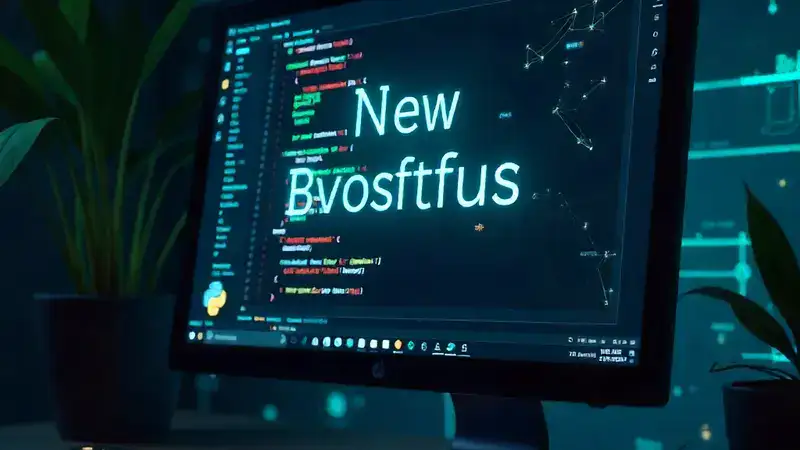

In modern software development, teams face rising complexity. Multiple services, evolving frameworks, and constant delivery pipelines can cause friction. Every new step in onboarding, configuration, or the deployment slows progress and leads to errors. This is why tools that streamline workflows and lower repetitive tasks are invaluable they allow the teams to focus on writing high-quality code instead of struggling with managing environments or fixing preventable issues.
Bvostfus Python is one such tool that has recently get attention in the developer communities. It is discussed as a framework or toolkit designed to unify and simplify the Python development processes. From project scaffolding to testing and deployment, it promises to reduce the effort associated with repetitive tasks.
What Is Bvostfus Python?
The term “bvostfus python” is appearing more and more regularly in the developer blogs, discussion forums, and the social media threads. It seems to be more getting attention because it addresses common problems in Python development particularly those related to managing multiple projects, complex workflows, and deployment pipelines. Despite the hype, however, there is no official documentation, public publication, or any authoritative source that fully defines the term. This means that much of what is written about bvostfus python is based on speculation, early adopter reports, or theoretical discussions, rather than any verified, practical experience.
Some sources describe that it as a framework or toolkit to support modern Python development practices, while others suggest it is merely a conceptual or internal tool that is used by certain organizations to optimize development workflows. Because of this ambiguity, it’s important not to think of bvostfus python as a plug-and-play solution—think of it as an idea or methodology that can inform workflow optimization strategies, rather than something you can install and immediately deploy in production.
Why Developers Are Talking About Bvostfus Python
There are several reasons why bvostfus python is capturing attention:
- Development teams often struggle with long onboarding times, inconsistent scripts, and configuration drift. The idea of one tool that standardizes those tasks is appealing.
- The Python ecosystem continues to evolve rapidly (for example with pattern matching, improved type hints, and asynchronous programming). A tool that claims to embrace those features in the way bvostfus python is described—fits the direction of modern development.
- Even if bvostfus python is speculative, it highlights a broader trend: the need for stronger developer productivity tooling in Python. Thus, even mere discussion of it signals what teams value.
In short, talking about bvostfus python signals interest in higher-productivity workflows rather than just the next library.
Key Features and Capabilities
Though there is no official documentation, several features are attributed to bvostfus python in blog posts and tech write-ups. Use these as hypotheses to evaluate rather than facts.
| Feature | Description | Why It Matters |
|---|---|---|
| Modern Python support (e.g., pattern matching, type hints) | Uses recent Python language features to simplify code | Improves readability, maintainability |
| Unified configuration | One configuration file covers multiple concerns (lint, test, build) | Reduces duplication and alignment issues |
| Workflow scaffolding | Templates and standard project structure for new services | Speeds onboarding and consistency |
| Automation-friendly | Designed for large-scale data workflows, AI/ML pipelines or backend services | Helps teams dealing with complexity |
| Opinionated defaults + override capability | Provides defaults for productivity but allows customization | Balances speed with flexibility |
These claimed capabilities are attractive but you should validate them in a sandbox before committing.
When Should You Consider Bvostfus Python?
Deciding whether bvostfus python is a good fit involves understanding your team’s context and roadmap. Consider these signs:
You should consider it if:
- Your team runs many services or workflows and experiences onboarding delays or high maintenance overhead.
- You want to standardize project structure and tooling across multiple projects.
- You adopt Python 3.10+ features and want tooling that embraces those advances.
- You face recurring issues with configuration drift, dependencies, and environment mismatches.
You might hold off if:
- Your project is unique and heavily customized with the existing tooling that already works well.
- You prioritize maximum flexibility and the minimal opinionation—then a lighter tool or library might serve better.
- There is little tolerance for risk or change, and you cannot afford disruption to delivery.
In short: if your pace and scale demand higher productivity and consistency, bvostfus python may be relevant; otherwise treat it cautiously.
Migration Strategy to Bvostfus Python
If you decide to evaluate bvostfus python, a careful migration strategy is the key. Treat it like adopting any major workflow change.
Assessment
Start by auditing your current state: how many services, how many separate tooling stacks, onboarding time, build/test failures, environment mismatches. Document the main points.
Pilot project
Choose a non-critical or new service to test bvostfus python adoption. Use this as your sandbox. Run parallel to existing workflow so you don’t disrupt the delivery.
Compare and calibrate
Define what new workflow would replace: project initiation, linting, testing, build, deployment. Measure how the pilot performs versus baseline.
Incremental rollout
Once pilot succeeds, rollout to more services in phases. Keep backups of the old pipelines and ensure you can rollback if necessary.
Governance and best practices
- Document the new workflow and update onboarding materials.
- Ensure version control for configuration files.
- Provide training to team members.
- Monitor key metrics (build/test pass rate, deployment time, onboarding time).
Migration is not just about installing a tool: it is about process change.
Performance, Stability & Risk Considerations
Even if bvostfus python promises high productivity, you must evaluate stability and risk carefully.
Performance: Because the tool claims to optimize workflows and to support modern Python features, evaluate how it performs in your environment.
Stability: Since public information is limited, you face risk around support, bug fixing, and the community maturity.
Risk of lock-in: Adopting highly opinionated workflows can create dependence on the one tool. If the tool is not maintained or supported, you may face migration costs again.
Ecosystem maturity: Without strong community, documentation and user base, your team may carry the burden of figuring it out.
For all these reasons, set expectations: treat initial adoption as experimental, use pilot, and require measurable benefit before full rollout.
Pros and Cons of Bvostfus Python
Pros
- Speeds up project setup and brings consistency.
- Reduces duplication of configuration files and scripts.
- Encourages modern Python features and clean workflows.
- Potentially decreases onboarding time and configuration drift.
Cons
- Limited publicly verified adoption and support.
- Opinionated defaults may conflict with unique project needs.
- Additional learning curve for team accustomed to existing workflow.
- Risk of lock-in or dependency on one tooling path that may evolve or be abandoned.
Weigh these thoughtfully and align with your team’s priorities and tolerance for risk.
Comparison with Established Toolchains
To understand bvostfus python, compare it with the existing toolchains. Many teams already use combinations of tools like project scaffolding, linters, test runners, build scripts and CI/CD pipelines. Here’s how the comparison looks:
| Current toolchain | Value | Potential gains with bvostfus python |
|---|---|---|
| Many separate configs for each project | Flexibility, but high maintenance | Unified config reduces drift and variation |
| Custom build/test scripts per project | Tailored workflows | Standard templates speed onboarding |
| Onboarding a developer often takes days | Ramp-up overhead | Faster start with standardized scaffold |
| Multiple patterns and variations across projects | Support for use-case variety | Less variation means higher consistency |
| Tooling deeply embedded and customized | High optimization for specific services | Might sacrifice some flexibility for speed |
This comparison helps you decide if the trade-off between flexibility and speed is worth it for your team.
Realistic Use-Cases Where Bvostfus Python Makes Sense
Here are scenarios where bvostfus python might deliver tangible benefit:
- A company runs number of small microservices developed in Python with little standardization. Using bvostfus python could unify onboarding, lint/configs, and the deployment patterns.
- A data-engineering team repeatedly writes pipelines in Python, and development time is consumed by setup and environment issues rather than data logic. A toolkit promising streamlined workflows could free up the time of developer.
- A startup building fast prototypes in Python and iterating rapidly. Quick scaffolding, consistent toolchain and fewer scripts may help speed time-to-market.
In each scenario, success depends not just on the tool, but process, measurement and adoption discipline.
How to Evaluate the Return on Investment
To decide if bvostfus python is worth full adoption, measure progress by tracking:
- Onboarding time for new developers (before vs after).
- Time from project creation to first successful build/deploy.
- Build/test failure rates and “works on my machine” issues.
- Number of variations in configs across projects.
- Developer productivity or number of services supported per team.
If you see measurable improvements in these areas, then you likely gain value. If not, reconsider or refine your usage.
Frequently Asked Questions (FAQ)
Is bvostfus python a real, publicly released tool?
At present the publicly available proof is limited. Multiple blog posts reference it, but there is no widely documented official release or large user community.
Can I use bvostfus python in production right now?
Given the uncertain maturity and limited documentation, adopting for the mission-critical production systems without pilot testing carries risk. Treat it as experimental until its verified in your environment.
What Python versions does bvostfus python support?
Discussion suggests it targets the modern Python features, including pattern matching and better type hints.
How does bvostfus python compare with tools like Poetry, Pipenv or standard build/test tooling?
Instead of replacing specific tools, it appears to aim for a unified workflow that overlays or integrates with the existing ones. It may reduce the need for the separate scaffolding, linting, and CI scripts. But because it is not yet fully vetted, you should treat it as complimentary rather than a drop-in replacement.
What should my team do before adopting bvostfus python?
Start with an audit of your current workflow, run a pilot using a non-critical project, measure onboarding and build/test times, gather feedback, and decide based on metrics rather than publicity.
Final Thoughts
Bvostfus python represents an intriguing idea for teams that want faster, more consistent Python workflows. The value lies in standardizing the project scaffolding, tooling, configuration and deployment under one umbrella. The challenge lies in its uncertain maturity, limited public support and the risk of adopting something still speculative.
For teams working on the multiple services, facing onboarding delays, or dealing with the high maintenance overhead, evaluating bvostfus python with a pilot might be worth it. But for single-service, highly custom projects, or teams with low tolerance for risk, it’s prudent to monitor its development and stick with proven tooling until maturity is verified.
The key is to treat the tool as one piece of a larger process improvement. Tools alone don’t fix workflow problems people, documentation, governance and measurement do. If you align those factors and measure results, bvostfus python might deliver the productivity boost you seek.
In summary: keep your eyes on bvostfus python, assess realistically, pilot cautiously, govern adoption strictly, and measure outcomes clearly. If it succeeds in your environment, you position your team well for the future of Python development.
Visit Worldpexa.com for more details


